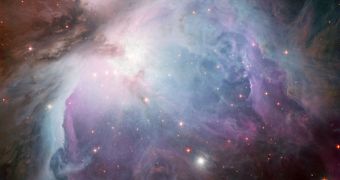Astronomers with the European Southern Observatory (ESO) have just released a new image of the famous Orion Nebula, one of the most well-known structure in space. The star-forming region was observed using the MPG/ESO 2.2-meter telescope at the La Silla Observatory, in Chile.
The Wide Field Imager (WFI) instrument proved to be the most suitable choice for this particular observations session, experts say, as it managed to tease out a wealth of details that past studies did not make out.
According to the team behind the work, the ethereal Orion Nebula was the target of the new analysis because it provides an excellent training ground for astronomers and astrophysicists to learn more about how stars are born, how they evolve, and how they die.
For this particular image, ESO experts used datasets that were selected by Russian astronomy enthusiast Igor Chekalin, the winner of the astrophotography competition called Hidden Treasures 2010, that ESO organized.
This view of Orion was the seventh-highest ranking entry in the contest, but the expert won with another, breath-taking image. The amateur astronomer had several compositions in the top 20.
“The Orion Nebula, also known as Messier 42, is one of the most easily recognizable and best-studied celestial objects. It is a huge complex of gas and dust where massive stars are forming and is the closest such region to the Earth,” ESO experts say in a statement.
“The glowing gas is so bright that it can be seen with the unaided eye and is a fascinating sight through a telescope. Despite its familiarity and closeness there is still much to learn about this stellar nursery,” they go on to say.
Astronomers say that at first, they believed the nebula to be more than 1,500 light-years away from our solar system. However, observations conducted back in 2007 showed that the cosmic structure is in fact some 1,350 light-years away.
This showed once and for all that there is still a lot to learn even about ultra-studied objects, of which we think we know everything. Scientists now hope to use the new image to learn how Orion, and indeed all other stellar nurseries, produce new, young stars.
This “image is a composite of several exposures taken through a total of five different filters. Light that passed through a red filter as well as light from a filter that shows the glowing hydrogen gas, were colored red,” the statement goes on to say.
“Light in the yellow–green part of the spectrum is colored green, blue light is colored blue and light that passed through an ultraviolet filter has been colored purple. The exposure times were about 52 minutes through each filter,” ESO experts conclude.

 14 DAY TRIAL //
14 DAY TRIAL //